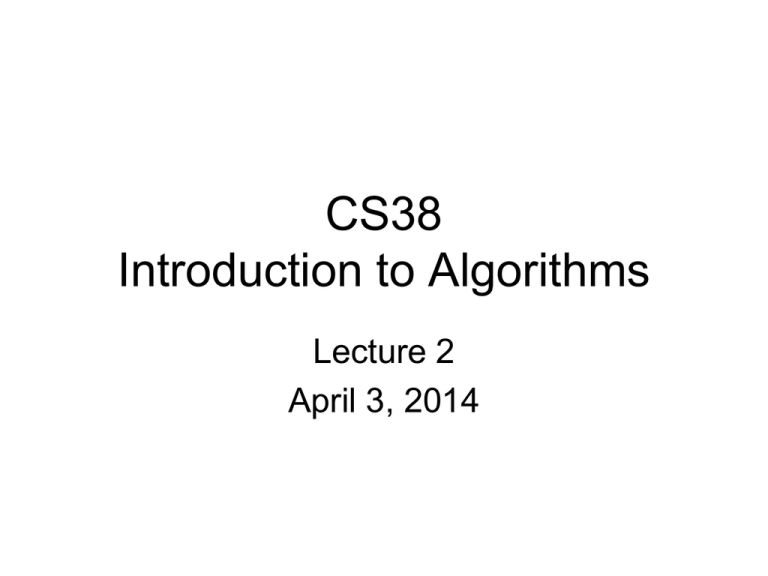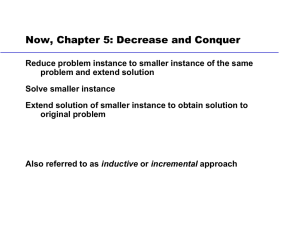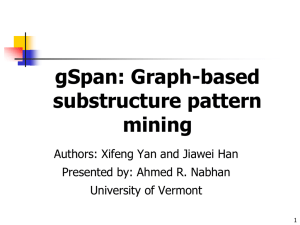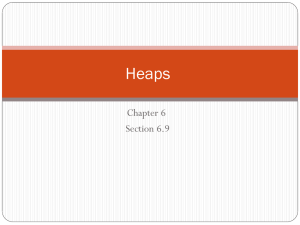ppt
advertisement

CS38
Introduction to Algorithms
Lecture 2
April 3, 2014
Outline
•
•
•
•
graph traversals (BFS, DFS)
connectivity
topological sort
strongly connected components
•
•
heaps and heapsort
greedy algorithms…
April 3, 2014
CS38 Lecture 2
2
Graphs
• Graph G = (V, E)
– directed or undirected
– notation: n = |V|, m = |E|
(note: m · n2)
– adjacency list or adjacency matrix
a
c
b
c
April 3, 2014
b
b
a
b
c
0
1
1
b
0
0
0
c
0
1
0
a
CS38 Lecture 2
a
b
c
3
Graphs
• Graphs model many things…
– physical networks (e.g. roads)
– communication networks (e.g. internet)
– information networks (e.g. the web)
– social networks (e.g. friends)
– dependency networks (e.g. topics in this course)
… so many fundamental algorithms operate
on graphs
April 3, 2014
CS38 Lecture 2
4
Graphs
• Graph terminology:
– an undirected graph is connected if there is a
path between each pair of vertices
– a tree is a connected, undirected graph with
no cycles; a forest is a collection of disjoint
trees
– a directed graph is strongly connected if there
is a path from x to y and from y to x, 8 x,y2V
– a DAG is a Directed Acyclic Graph
April 3, 2014
CS38 Lecture 2
5
Graph traversals
• Graph traversal algorithm: visit some or all
of the nodes in a graph, labeling them with
useful information
– breadth-first: useful for undirected, yields
connectivity and shortest-paths information
– depth-first: useful for directed, yields
numbering used for
• topological sort
• strongly-connected component decomposition
April 3, 2014
CS38 Lecture 2
6
Breadth first search
BFS(undirected graph G, starting vertex s)
1. for each vertex v, v.color = white, v.dist = 1, v.pred = nil
2. s.color = grey, s.dist = 0, s.pred = nil
3. Q = ;; ENQUEUE(Q, s)
4. WHILE Q is not empty u = DEQUEUE(Q)
5.
for each v adjacent to u
6.
IF v.color = white THEN
7.
v.color = grey, v.dist = u.dist + 1, v.pred = u
8.
ENQUEUE(Q, v)
9.
u.color = black
Lemma: BFS runs in time O(m + n), when G is represented
by an adjacency list.
April 3, 2014
CS38 Lecture 2
7
BFS example from CLRS
8
Breadth first search
Lemma: for all v 2 V, v.dist = distance(s, v), and a
shortest path from s to v is a shortest path from
s to v.pred followed by edge (v.pred,v)
Proof: partition V into levels
– L0 = {s}
– Li = {v : 9 u 2 Li-1 such that (u,v) 2 E}
– Observe: distance(s,v) = i , v 2 Li
edges only within
layers or between
adjacent layers
s
L0
L1
L2
Ln
Breadth first search
edges only within
layers or between
adjacent layers
s
L1
L0
L2
Ln
Claim: at any point in operation of algorithm:
1. black/grey vertices exactly L0, L1, …, Li and part of Li+1
2. Q = (v0, v1, v2, v3, …, vk) and all have v.dist = level of v
level i
level i+1
holds initially: s.color = grey, s.dist = 0, Q = (s)
April 3, 2014
CS38 Lecture 2
10
Breadth first search
edges only within
layers or between
adjacent layers
s
L1
L0
L2
Ln
Claim: at any point in operation of algorithm:
1. black/grey vertices exactly L0, L1, …, Li and part of Li+1
2. Q = (v0, v1, v2, v3, …, vk) and all have v.dist = level of v
level i
level i+1
) level ¸ i+1
) level · i+1
1 step: dequeue v0; add white nbrs of v0 w/ dist = v0.dist + 1
April 3, 2014
CS38 Lecture 2
11
Depth first search
DFS(directed graph G)
1. for each vertex v, v.color = white, v.pred = nil
2. time = 0
3. for each vertex u, IF u.color = white THEN DFS-VISIT(G, u)
DFS-VISIT(directed graph G, starting vertex u)
1. time = time +1, u.discovered = time, u.color = grey
2. for each v adjacent to u, IF v.color = white THEN
3.
v.pred = u, DFS-VISIT(G, v)
4. u.color = black; time = time + 1; u.finished = time
Lemma: DFS runs in time O(m + n), when G is represented
by an adjacency list.
Proof?
April 3, 2014
CS38 Lecture 2
12
Depth first search
DFS(directed graph G)
1. for each vertex v, v.color = white, v.pred = nil
2. time = 0
3. for each vertex u, IF u.color = white THEN DFS-VISIT(G, u)
DFS-VISIT(directed graph G, starting vertex u)
1. time = time +1, u.discovered = time, u.color = grey
2. for each v adjacent to u, IF v.color = white THEN
3.
v.pred = u, DFS-VISIT(G, v)
4. u.color = black; time = time + 1; u.finished = time
Lemma: DFS runs in time O(m + n), when G is represented
by an adjacency list.
Proof: DFS-VISIT called for each vertex exactly once; its
adj. list scanned once; O(1) work
April 3, 2014
CS38 Lecture 2
13
Depth first search
• DFS yields a forest: “the DFS forest”
• each vertex labeled with discovery time
and finishing time
• edges of G classified as
– tree edges
– back edges (point back to an ancestor)
– forward edges (point forward to a descendant)
– cross edges (all others)
April 3, 2014
CS38 Lecture 2
14
DFS example from CLRS
DFS application: topological sort
• Given DAG, list vertices v0, v1, …., vn so
that no edges from vi to vj (j < i)
a
d
example:
b
c
a
April 3, 2014
b
f
d
CS38 Lecture 2
f
e
e
c
16
DFS application: topological sort
Theorem: listing vertices in reverse order of
DFS finishing times yields a topological sort
of DAG G
(can implement in linear time; how?)
Proof: claim for all (u,v) 2 E, v.finish < u.finish
– when (u,v) explored, v not grey since then G
would have a cycle
[back-edge]
– v white ) descendent of u so v finishes first
– v black ) already done, so v.finish is set and
u.finish will be set with a later time
April 3, 2014
CS38 Lecture 2
17
Strongly connected components
• say that x » y if there is a directed path
from x to y and from y to x in G
• equivalence relation, equivalence classes
are strongly connected components of G
– also, maximal strongly connected subsets
• SCC structure is a DAG (why?)
April 3, 2014
CS38 Lecture 2
18
Strongly connected components
• DFS tree from v in G: all nodes reachable
from v
G with edges reversed
• DFS tree from v in GT: all nodes that can
reach v
v
• Key: in sink SCC, this is exactly the SCC
April 3, 2014
CS38 Lecture 2
19
Strongly connected components
v
• given v in a sink SCC, run DFS starting there,
then move to next in reverse topological order…
– DFS forest would give the SCCs
• Key #2: topological ordering consistent
with SCC DAG structure! (why?)
April 3, 2014
CS38 Lecture 2
20
Strongly connected components
SCC(directed graph G)
1. run DFS(G)
2. construct GT from G
3. run DFS(GT) but in line 3, consider vertices in decreasing
order of finishing times from the first DFS
• running time O(n + m) if G in adj. list
– note: step 2 can be done in O(m + n) time
• trees in DFS forest of the second DFS are
the SCCs of G
April 3, 2014
CS38 Lecture 2
21
Strongly connected components
SCC(directed graph G)
1. run DFS(G)
2. construct GT from G
3. run DFS(GT) but in line 3, consider vertices in decreasing
order of finishing times from the first DFS
Correctness (sketch):
– first vertex is in sink SCC, DFS-VISIT colors
black, effectively removes
– next unvisited vertex is in sink after removal
– and so on…
April 3, 2014
CS38 Lecture 2
22
Summary
• O(m + n) time algorithms for
– computing BFS tree from v in undirected G
– finding shortest paths from v in undirected G
– computing DFS forest in directed G
– computing a topological ordering of a DAG
– identifying the strongly connected
components of a directed G
(all assume G given in adjacency list format)
April 3, 2014
CS38 Lecture 2
23
Heaps
• A basic data structure beyond stacks and
queues: heap
– array of n elt/key pairs in special order
– min-heap or max-heap
operations:
INSERT(H, elt)
INCREASE-KEY(H, i)
EXTRACT-MAX(H)
April 3, 2014
CS38 Lecture 2
24
Heaps
• A basic data structure beyond stacks and
queues: heap
– array of n elt/key pairs in special order
– min-heap or max-heap
operations:
time:
INSERT(H, elt)
INCREASE-KEY(H, i)
EXTRACT-MAX(H)
April 3, 2014
CS38 Lecture 2
O(log n)
O(log n)
O(log n)
25
Heaps
• array A represents a binary tree that is full
except for possibly last “row”
parent(i) =
bi/2c
left(i) = 2i
right(i) = 2i+1
height =
O(log n)
• heap property: A[parent(i)] ¸ A[i] for all i
April 3, 2014
CS38 Lecture 2
26
Heaps
• key operation: HEAPIFY-DOWN(H, i)
A[i] may violate heap property
– repeatedly swap with larger child
– running time? O(log n) or O(ht)
April 3, 2014
CS38 Lecture 2
27
Heaps
• key operation: HEAPIFY-UP(H, i)
A[i] may violate heap property
– repeatedly swap with larger child
– running time? O(log n) or O(ht)
April 3, 2014
CS38 Lecture 2
28
Heaps
• How do you implement
operations:
time:
INSERT(H, elt)
INCREASE-KEY(H, i)
EXTRACT-MAX(H)
O(log n)
O(log n)
O(log n)
using HEAPIFY-UP and HEAPIFY-DOWN?
• BUILD-HEAP(A): re-orders array A so that it
satisfies heap property
– how do we do this? running time?
April 3, 2014
CS38 Lecture 2
29
Heaps
• BUILD-HEAP(A): re-orders array A so that it
satisfies heap property
– call HEAPIFY-DOWN(H, i)
for i from n downto 1
– running time O(n log n)
– more careful analysis: O(n)
April 3, 2014
CS38 Lecture 2
30
Heaps
• suffices to show h¸0 h/2h = O(1)
• note: h¸0 ch = O(1) for c < 1
• observe: (h+1)/2h+1 = h/(2h) ¢ (1+1/h)/2
• (1+1/h)/2 < 1 for h > 1
April 3, 2014
CS38 Lecture 2
31
Heapsort
• Sorting n numbers using a heap
– BUILD-HEAP(A)
– repeatedly EXTRACT-MIN(H)
n)
– total O(n log n)
O(n)
n¢O(log
• Can we do better? O(n)?
– observe that only ever compare values
– no decisions based on actual values of keys
April 3, 2014
CS38 Lecture 2
32
Sorting lower bound
comparison-based sort: only information
about A used by algorithm comes from
pairwise comparisons
– heapsort, mergesort, quicksort, …
visualize sequence of comparisons in tree:
“is A[i] · A[j]?”
• each root-leaf path
consistent with 1 perm.
• maximum path length
¸ log(n!) = (n log n)
April 3, 2014
CS38 Lecture 2
33
Greedy
Algorithms
April 3, 2014
CS38 Lecture 2
34
Greedy algorithms
• Greedy algorithm paradigm
– build up a solution incrementally
– at each step, make the “greedy” choice
Example: in undirected graph G = (V,E), a vertex
cover is a subset of V that touches every edge
– a hard problem: find the smallest vertex cover
a
d
b
c
April 3, 2014
a
b
f
e
d
f
c
CS38 Lecture 2
35
Dijkstra’s algorithm
• given
– directed graph G = (V,E) with non-negative
edge weights
– starting vertex s 2 V
• find shortest paths from s to all nodes v
– note: unweighted case solved by BFS
April 3, 2014
CS38 Lecture 2
36
Dijkstra’s algorithm
• shortest paths exhibit “optimal substructure”
property
– optimal solution contains within it optimal
solutions to subproblems
– a shortest path from x to y via z contains a shortest
path from x to z
• shortest paths from s form a tree rooted at s
• Main idea:
– maintain set S µ V with correct distances
– add nbr u with smallest “distance estimate”
April 3, 2014
CS38 Lecture 2
37








